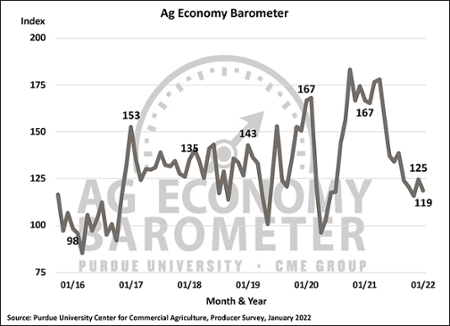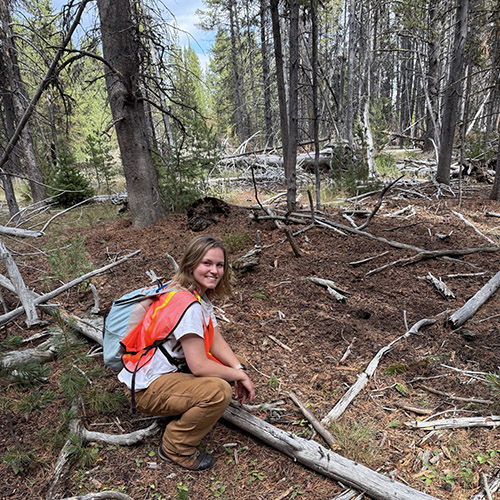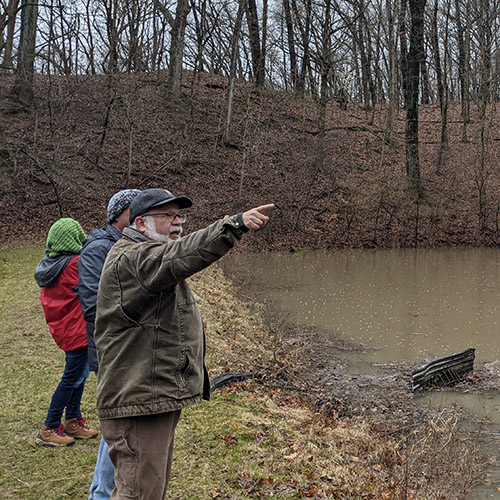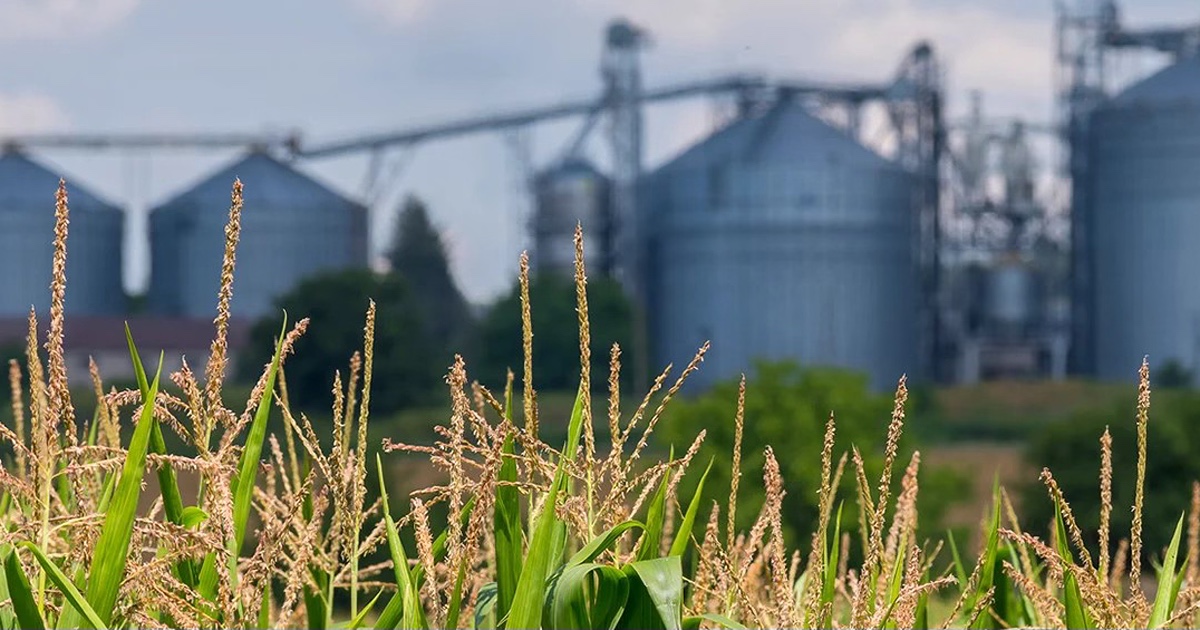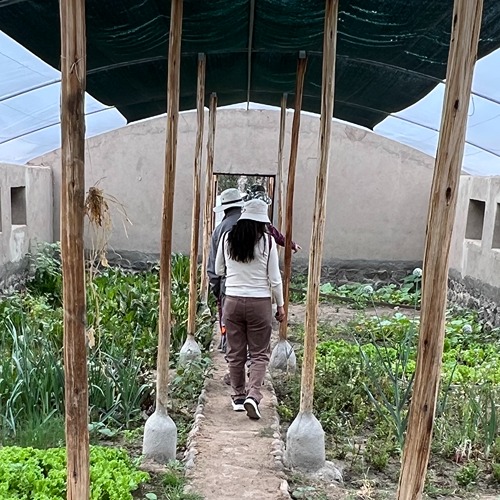Ag Economy Barometer declines, producers concerned about rising costs and supply chain disruptions
Farmer sentiment weakened in January as the Purdue University/CME Group Ag Economy Barometer declined 6 points to a reading of 119, its second-lowest reading since July 2020. The Index of Current Conditions fell 13 points to a reading of 133, while the Index of Future Expectations changed little in January, down 2 points to a reading of 112. The Ag Economy Barometer is calculated each month from 400 U.S. agricultural producers’ responses to a telephone survey. This month’s survey was conducted Jan. 17-21.
“Rising farm input costs and ongoing supply chain disruptions appear to be contributing to producers’ weaker perception of current conditions and expectations of their farm’s financial performance in 2022 when compared to last year,” said James Mintert, the barometer’s principal investigator and director of Purdue University’s Center for Commercial Agriculture.
The Farm Financial Performance Index fell sharply in January to a reading of 83, a 30% decline compared with a year earlier, and 27% lower than in December 2021. The financial index is generated based upon producers’ responses to whether they expect their farm's current financial performance to be better than, worse than or about the same as the previous year.
“The sharp drop in the financial performance index this month indicates producers expect a sharp decline in income in 2022 compared to 2021. In the December survey, producers were focused on comparing a very positive income year, 2021, to 2020, which really supported the index at year end,” Mintert said.
The Farm Capital Investment Index also weakened this month, falling 4 points to a reading of 45. In January, 52% of respondents said they plan to reduce their farm machinery purchases in the upcoming year. Supply chain issues continue to hamper farmers’ investment plans as, for the third month in a row, over 40% of producers reported that low farm machinery inventories were holding back their purchase plans. Farm construction plans were also weaker this month as 66% of respondents reported reducing their construction plans in the year ahead versus last year.
Supply chain concerns extend beyond farm machinery and farm building/grain bin construction plans. Disruptions in the supply chain for many farm inputs, coupled with strong demand, are pushing production costs higher. Fifty-seven percent of survey respondents in January said they expect farm input prices to rise by 20% or more in 2022, and 34% of producers said they expect prices to rise by 30% or more.
The disruptions extend not just to input pricing, but also input availability. In January, 28% of producers responding to the survey said they have had difficulty purchasing crop inputs from suppliers for the 2022 crop season. In a follow-up question posed to producers experiencing difficulty in procuring crop inputs, respondents reported difficulty in purchasing a broad spectrum of crop inputs including herbicides, insecticides, fertilizer, and farm machinery parts.
Prices for nitrogen fertilizer have skyrocketed over the last year. According to the U.S Department of Agriculture, anhydrous ammonia (NH3) prices in Illinois during January 2022 were nearly triple what they were in January 2021. Although a majority (57%) of corn producers said they intend to use the same nitrogen application rate in 2022 as in 2021, nearly four out of 10 (37%) said they intend to reduce their nitrogen application rate compared with last year.
The rise in farm input costs was also the primary reason why many producers are expecting to have a larger operating loan in 2022. This month, 27% of respondents said they expect to have a larger operating loan in 2022 than a year earlier, 10 points higher than on last year’s survey and 12 points higher than two years ago.
For the second month in a row, both the short-term and long-term farmland value indices declined. The Short-Term Farmland Value Index declined 11 points to an index value of 142, while the Long-Term Farmland Value Index declined 7 points to a reading of 145 in January. Both indices have fallen about 10% compared with their fall 2021 peak values.
“Recent weakness in both indices could reflect recognition of how much farmland values have increased over the last year or more, tempering expectations for further price increases,” Mintert said.
Read the full Ag Economy Barometer report at https://purdue.ag/agbarometer. The site also offers additional resources – such as past reports, charts and survey methodology – and a form to sign up for monthly barometer email updates and webinars.
Each month, the Purdue Center for Commercial Agriculture provides a short video analysis of the barometer results. For even more information, check out the Purdue Commercial AgCast podcast. It includes a detailed breakdown of each month’s barometer, in addition to a discussion of recent agricultural news that affects farmers.
The Ag Economy Barometer, Index of Current Conditions and Index of Future Expectations are available on the Bloomberg Terminal under the following ticker symbols: AGECBARO, AGECCURC and AGECFTEX.
About the Purdue University Center for Commercial Agriculture
The Center for Commercial Agriculture was founded in 2011 to provide professional development and educational programs for farmers. Housed within Purdue University’s Department of Agricultural Economics, the center’s faculty and staff develop and execute research and educational programs that address the different needs of managing in today’s business environment.
About CME Group
As the world’s leading and most diverse derivatives marketplace, CME Group enables clients to trade futures, options, cash and OTC markets, optimize portfolios, and analyze data – empowering market participants worldwide to efficiently manage risk and capture opportunities. CME Group exchanges offer the widest range of global benchmark products across all major asset classes based on interest rates, equity indexes, foreign exchange, energy, agricultural products and metals. The company offers futures and options on futures trading through the CME Globex® platform, fixed income trading via BrokerTec and foreign exchange trading on the EBS platform. In addition, it operates one of the world’s leading central counterparty clearing providers, CME Clearing. With a range of pre- and post-trade products and services underpinning the entire lifecycle of a trade, CME Group also offers optimization and reconciliation services through TriOptima, and trade processing services through Traiana.
CME Group, the Globe logo, CME, Chicago Mercantile Exchange, Globex, and E-mini are trademarks of Chicago Mercantile Exchange Inc. CBOT and Chicago Board of Trade are trademarks of Board of Trade of the City of Chicago, Inc. NYMEX, New York Mercantile Exchange and ClearPort are trademarks of New York Mercantile Exchange, Inc. COMEX is a trademark of Commodity Exchange, Inc. BrokerTec, EBS, TriOptima, and Traiana are trademarks of BrokerTec Europe LTD, EBS Group LTD, TriOptima AB, and Traiana, Inc., respectively. Dow Jones, Dow Jones Industrial Average, S&P 500, and S&P are service and/or trademarks of Dow Jones Trademark Holdings LLC, Standard & Poor’s Financial Services LLC and S&P/Dow Jones Indices LLC, as the case may be, and have been licensed for use by Chicago Mercantile Exchange Inc. All other trademarks are the property of their respective owners.

